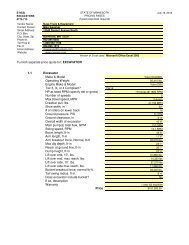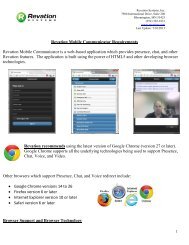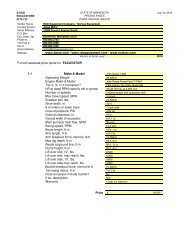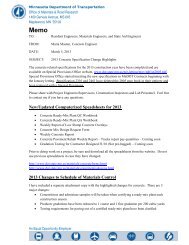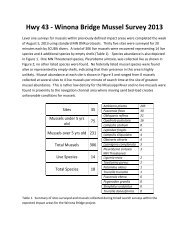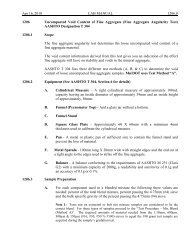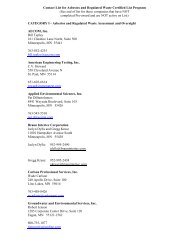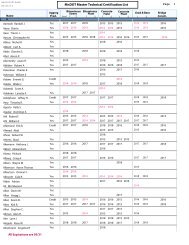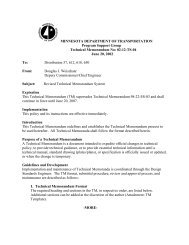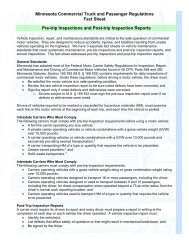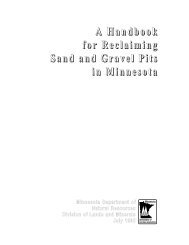A Moving Experience - Minnesota Department of Transportation
A Moving Experience - Minnesota Department of Transportation
A Moving Experience - Minnesota Department of Transportation
You also want an ePaper? Increase the reach of your titles
YUMPU automatically turns print PDFs into web optimized ePapers that Google loves.
A <strong>Moving</strong><br />
<strong>Experience</strong><br />
A Practical Guide to<br />
<strong>Moving</strong><br />
Office <strong>of</strong> Freight and<br />
Commercial Vehicle<br />
Operations<br />
<strong>Minnesota</strong> <strong>Department</strong> <strong>of</strong><br />
<strong>Transportation</strong>
Table <strong>of</strong> Contents<br />
Choosing a Household Goods Mover . . . . . . . 3<br />
Obtaining an Estimate . . . . . . . . . . . . . . . . . . . 4<br />
Understanding the Bill <strong>of</strong> Lading Contract . . . 5<br />
Requiring a Driver’s Order . . . . . . . . . . . . . . . . 6<br />
Paying <strong>Transportation</strong> Charges . . . . . . . . . . . 7<br />
Determining the Need for Insurance . . . . . . . . 7<br />
Agreeing on Shipment Dates . . . . . . . . . . . . . . 8<br />
Reporting Damage Claims . . . . . . . . . . . . . . . . 9<br />
Remembering the Basics . . . . . . . . . . . . . . . . 10<br />
<strong>Moving</strong> Tips for Building your own<br />
Checklist . . . . . . . . . . . . . . . . . . . . . . . . . . . . . 11<br />
2
Choosing a Household Goods Mover<br />
This booklet is published to assist consumers who are moving their<br />
household goods within <strong>Minnesota</strong> (intrastate). It provides advice on<br />
choosing a mover and explanations <strong>of</strong> common business terms and<br />
practices. If you are moving to another state (interstate), contact the<br />
Federal Motor Carrier Safety Administration at 1-888-DOT-SAFT or<br />
visit www.protectyourmove.gov.<br />
When moving within <strong>Minnesota</strong>, several laws are in place to protect<br />
the consumer. All movers in <strong>Minnesota</strong> must have a permit from the<br />
<strong>Minnesota</strong> <strong>Department</strong> <strong>of</strong> <strong>Transportation</strong> (MnDOT) and be insured.<br />
Movers are issued a unique identification number by MnDOT. This<br />
number is required on all advertisements and <strong>of</strong>ficial publications. To<br />
check if a mover has a valid permit and is insured, contact MnDOT’s<br />
Office <strong>of</strong> Freight and Commercial Vehicle Operations at (651) 215-<br />
6330. Anyone who makes arrangements for moving household<br />
goods for hire must hold a MnDOT permit.<br />
Other resources for finding reputable movers and other helpful tips for<br />
moving are the Better Business Bureau (BBB) and industry trade<br />
associations.<br />
3
Obtaining an Estimate<br />
The cost <strong>of</strong> the move will be estimated based on either an hourly<br />
charge or based on the weight or volume <strong>of</strong> your belongings and the<br />
distance they are shipped. Moves <strong>of</strong> 50 miles or less are most <strong>of</strong>ten<br />
based on hourly charges. Movers generally initiate a “distance scale”<br />
(weight or volume times distance shipped) for moves over 50 miles.<br />
To help you anticipate the cost <strong>of</strong> the move, a mover will give you an<br />
estimate <strong>of</strong> the price. Make sure the mover sees all items to be<br />
moved, and reach a clear understanding about the amount <strong>of</strong> packing<br />
and other services needed. Anything omitted from the estimate but<br />
later included in the shipment will add to the cost. There is no<br />
guarantee that the final cost will not be more than the estimate.<br />
Movers are legally obligated to collect no more and no less than the<br />
charges published in their tariffs for services provided. Tariffs are filed<br />
with MnDOT and are available for review. The amount <strong>of</strong> charges<br />
must be on the driver’s order and bill <strong>of</strong> lading relating to your<br />
shipment. You pay what is billed at the time <strong>of</strong> delivery unless some<br />
other arrangement has been made with the mover.<br />
4
Understanding the Bill <strong>of</strong> Lading<br />
Contract<br />
The bill <strong>of</strong> lading is the contract between you and the mover. The<br />
mover is required by law to prepare a bill <strong>of</strong> lading for every shipment<br />
it transports. The information on the bill <strong>of</strong> lading must be the same<br />
information shown on the driver’s order for service. Before the<br />
shipment is loaded, you must receive a copy <strong>of</strong> the bill <strong>of</strong> lading,<br />
which you must sign. It is your responsibility to read the bill <strong>of</strong> lading<br />
before you accept it. The bill <strong>of</strong> lading requires the mover to provide<br />
the service you have requested, and you must pay the charges for<br />
the service. When the shipment is delivered, it is your responsibility to<br />
check the items delivered against the bill <strong>of</strong> lading.<br />
5
Requiring a Driver’s Order<br />
In <strong>Minnesota</strong> a household goods mover is not required to provide you<br />
with a written estimate. However, the mover is required to provide the<br />
driver a written order, which shows the name and pickup address <strong>of</strong><br />
the shipper, the delivery address <strong>of</strong> the shipment, the time <strong>of</strong> the<br />
pickup, the items to be transported and the estimate <strong>of</strong> the charges<br />
for the shipment. The rates and charges on the order must agree with<br />
the mover’s tariff on file with MnDOT. If at the time <strong>of</strong> pickup the<br />
driver finds that there are additional items to be transported other<br />
than those named in the order, or if there are other reasons the order<br />
must be revised, the adjustment must be noted on the driver’s order<br />
and signed by you. A copy <strong>of</strong> this order must be given to you. If you<br />
request the mover to provide more services than those included in<br />
the order, expect to pay in full for the added services at time <strong>of</strong><br />
delivery.<br />
6
Paying <strong>Transportation</strong> Charges<br />
If your shipment was transported on a collect-on-delivery basis<br />
(COD), you will be expected to pay the total charges appearing on<br />
the freight bill at the time <strong>of</strong> delivery. Movers customarily provide in<br />
their tariffs that freight charges be paid in cash, by certified check,<br />
credit card, or money order. When this requirement exists, the mover<br />
will not accept personal checks—so check with your mover before<br />
moving day to see what forms <strong>of</strong> payment are accepted.<br />
Determining the Need for Insurance<br />
At or before the time <strong>of</strong> pickup, you and the mover should determine<br />
insurance coverage for any possible loss or damage to the goods<br />
being moved. High-value items may need additional coverage.<br />
<strong>Minnesota</strong> law requires household goods movers to call your<br />
attention to the “released value” <strong>of</strong> the goods as fixed in the mover’s<br />
tariff. You must sign a statement acknowledging the released value.<br />
The term “released value” refers to the amount <strong>of</strong> financial risk the<br />
mover assumes while your household items are entrusted to the<br />
mover for transport. In <strong>Minnesota</strong>, the minimum released value that a<br />
mover must assume is $.60 per pound per article. For example, if a<br />
10-pound lamp is lost or damaged, the most you could recover is<br />
$6.00 (10 lbs. x $.60). To choose this option, you must sign the bill <strong>of</strong><br />
lading acknowledging the released value at “60 cents per pound per<br />
article.”<br />
You also have the option <strong>of</strong> declaring the actual value <strong>of</strong> the shipment<br />
and writing it on the bill <strong>of</strong> lading (“declared value”). That amount will<br />
be the mover’s maximum liability to you. There will be a charge for<br />
this coverage depending on the mover’s tariff. If there is a claim, the<br />
7
mover will repair or replace according to an item’s depreciated value.<br />
If you do not agree to a released value <strong>of</strong> $.60 cents per pound or<br />
declare a value, the mover’s maximum liability is $1.25 a pound.<br />
You may also elect to purchase “trip transit insurance” in a specified<br />
amount. A certificate <strong>of</strong> insurance issued by either the mover or by an<br />
insurance company must be provided to you. Ask if there is a<br />
deductible. There will be additional charges for this type <strong>of</strong> coverage.<br />
Check with your insurance agent to see if this type <strong>of</strong> coverage is<br />
available under your home owner’s policy.<br />
Agreeing on Shipment Dates<br />
It is your responsibility to determine which date, or between which<br />
dates, you need to have the shipment picked up and on which date<br />
you require delivery. The dates or periods <strong>of</strong> time you and the mover<br />
agree upon should be definite, not “as soon as possible.” The mover<br />
is required to have the agreed dates on the driver’s order. The dates<br />
you have agreed upon must also be entered on the bill <strong>of</strong> lading and<br />
become part <strong>of</strong> your contract with the mover.<br />
8
Reporting Damage Claims<br />
If any <strong>of</strong> your household goods are damaged or lost, report the facts<br />
promptly and in detail on the driver’s order, bill <strong>of</strong> lading, or inventory<br />
sheet before you sign it. If you notice damage after unpacking, a<br />
claim must be filed within nine months after delivery or, in case <strong>of</strong><br />
failure to make delivery, within nine months after a reasonable time<br />
for delivery has elapsed. If a mover denies or disallows your claim,<br />
you have two years and one day from the date <strong>of</strong> the mover’s written<br />
denial to institute a civil suit.<br />
MnDOT can help customers who are having problems with a mover<br />
who does not honor its coverage responsibilities for damage or loss.<br />
MnDOT does not have authority to determine mover liability in<br />
particular circumstances or the amount necessary to repair or replace<br />
items. MnDOT does not act as a collection agency.<br />
9
Remembering the Basics<br />
1. <strong>Moving</strong> companies provide a variety <strong>of</strong> services with a wide range<br />
<strong>of</strong> fees. Compile a list <strong>of</strong> movers; inform them <strong>of</strong> the destination<br />
and timing <strong>of</strong> your move; ask about services they <strong>of</strong>fer; and make<br />
sure you understand their estimates. Then compare and see<br />
which mover suits your needs and budget.<br />
2. Check with MnDOT or FMCSA to see if the mover you select is<br />
licensed. Check with the Better Business Bureau to see if there<br />
have been any complaints that raise concerns.<br />
3. When you choose your mover, be sure you understand:<br />
a. The rates and charges that will apply;<br />
b. The mover’s liability for your belongings;<br />
c. How pickup and delivery will work; and<br />
d. What claims protection you have.<br />
4. Specify pickup and delivery dates in the order for service.<br />
5. The bill <strong>of</strong> lading is your contract with the mover. Read it carefully.<br />
If you have any questions ask your mover.<br />
6. All agreements should be in writing.<br />
7. Any changes should also be in writing, initialed by you and the<br />
mover.<br />
8. Be sure you understand the extent <strong>of</strong> your mover’s liability for<br />
loss and damage.<br />
9. You have the right to be present each time your shipment is<br />
weighed.<br />
10
<strong>Moving</strong> Tips for Building your own<br />
Checklist<br />
• Check with MnDOT’s Office <strong>of</strong> Freight and Commercial Vehicle<br />
Operations to make sure the carrier has a permit to operate and<br />
is licensed and insured. MnDOT cannot recommend one carrier<br />
over another.<br />
• Check with the Better Business Bureau to see if a mover is a<br />
member and if any complaints have been filed against them.<br />
• Schedule your move with a mover about a month in advance.<br />
• If you are packing your own goods, don’t overload the cartons.<br />
Mark and note contents and room destination on the outside <strong>of</strong><br />
each box. Remember to label any fragile articles.<br />
• Do not pack money, valuable jewelry, medication, important<br />
papers, or food. Carry these with you.<br />
• If moving antiques or artwork <strong>of</strong> extraordinary value, obtain<br />
written appraisals <strong>of</strong> items to verify value. Check with your mover<br />
about additional insurance for these items.<br />
• Be ready on moving day. Movers usually charge on an hourly<br />
basis, so the more prepared you are, the less expensive the final<br />
bill will be.<br />
• If possible have a responsible person both at the origin and<br />
destination sites to oversee the movers.<br />
11
To request this document in an alternative format, please contact the<br />
Affirmative Action Office at 651-366-4723 or 1-800-657-3774 (Greater<br />
<strong>Minnesota</strong>); or 711 or 1-800-627-3529 (<strong>Minnesota</strong> Relay).<br />
You may also send an e-mail to ADArequest.dot@state.mn.us.<br />
(Please request at least one week in advance).<br />
12<br />
<strong>Minnesota</strong> <strong>Department</strong> <strong>of</strong> <strong>Transportation</strong><br />
Office <strong>of</strong> Freight and Commercial Vehicle Operations<br />
395 John Ireland Boulevard, Mail Stop 420<br />
St. Paul, MN 55155-1899<br />
651-215-6330 Fax: 651-366-3718<br />
www.dot.state.mn.us/cvo




